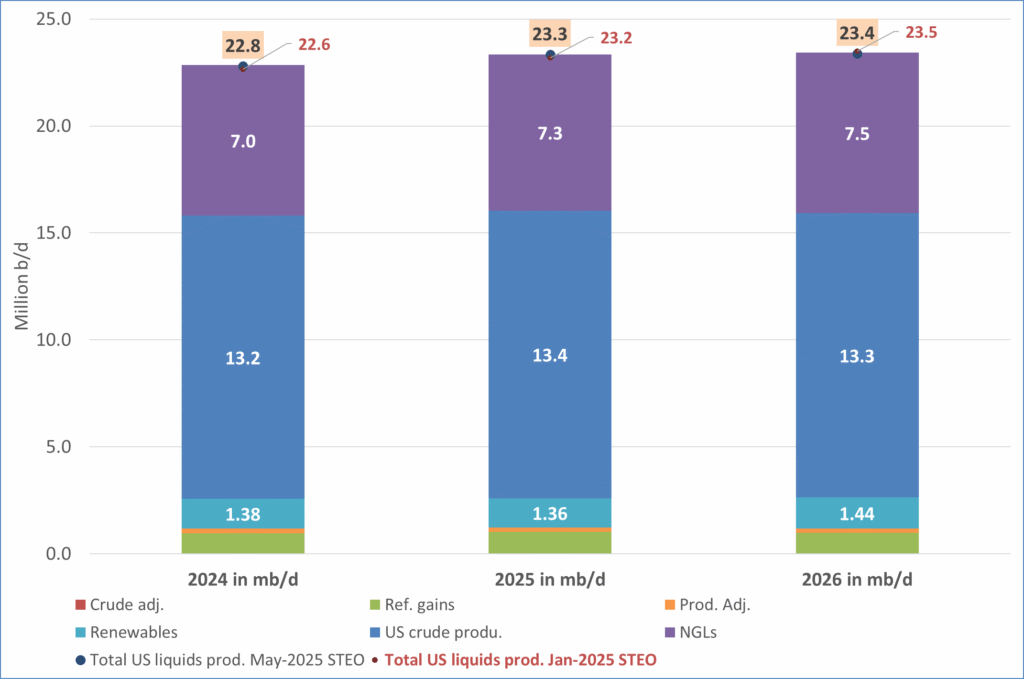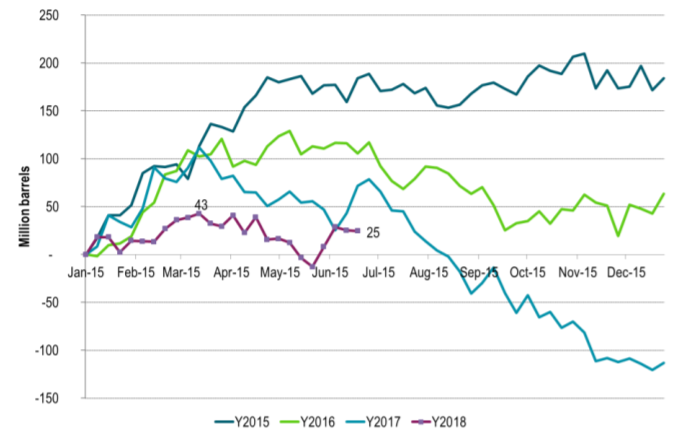Analys
Iran – Hard to swallow a double insult

 Brent crude fell back 0.3% to $75.08/bl ydy after a strong rebound on Mon but is again up 0.8% this morning to $75.7/bl. It is taking little notice of the escalating trade war between the US and China which is threatening global growth and oil demand growth down the road. It is not even daunted by the repeated proposition by Russia to lift the production cap by 1.5 m bl/d.
Brent crude fell back 0.3% to $75.08/bl ydy after a strong rebound on Mon but is again up 0.8% this morning to $75.7/bl. It is taking little notice of the escalating trade war between the US and China which is threatening global growth and oil demand growth down the road. It is not even daunted by the repeated proposition by Russia to lift the production cap by 1.5 m bl/d.
Iran is naturally offended and disgusted by first having US sanctions reactivated forcing down its production and exports and then at the same time seeing Donald calling for more oil from from OPEC+ in order to push oil prices lower and appease US consumers so the Republicans can make a good mid-term election in Nov. Iran is thus naturally opposing any suggestion of an increase in production. Iran argues that if the oil price now goes high and the US consumers suffers at the pump then Donald is directly to be blamed for this due to the Iran sanctions.
Apparently it looks like Saudi Arabia wants more oil from OPEC+ because Donald Trump is asking for it as a return favour for reviving sanctions towards Iran and standing by Saudi Arabia as a long term ally. Thus even if the most sensible and responsible thing to do is to increase production in the face of collapsing production in Venezuela and now also Libya it will be extremely difficult for Iran to swallow a decision to increase production. It would be a double insult to see the “US bully” first having its way with Iran and then having its way with OPEC+.
It is important to remember that OPEC+ has been extremely lucky with its production cuts. Yes, they have been good and delivered on their cuts but they have also definitely been lucky. If it had not been for a continuous improvement in the global economy since late 2016 and thus strong oil demand growth and a collapsing production in Venezuela then things might have looked quite differently today. Then the group might have had to cut deeper and then yet deeper again in 2019. Now instead the five active cutters (Saudi Arabia, Kuwait, UAE, Iraq and Russia), can and should responsibly exit their cuts in order to avoid a further rallying in the oil price towards $100/bl in 2H18. An oil price of $75/bl is already taxing global consumers (ex-US) as when the oil price was $110/bl back in 2011 to 2014 due to the today much stronger USD. Thus having the oil price rallying to $100/bl in 2H18 at today’s dollar strength would not be good for the global economy at all.
By exiting cuts and reviving production the group is achieving two things. Firs it avoids creating unnecessary risk of hurting global growth and thus oil demand growth. Worst case if OPEC+ does not revive production would be a real spike in the oil price tipping the global economy into recession. In that case there would be no exit from current cuts as an option and instead the cutters would potentially have to cut yet deeper in the face of booming US shale oil production and a tanking global economy. Secondly, by exiting cuts now that it is possible and necessary to do so it will strengthen the position of the group to cut the next time it is a need for cuts by the group.
Thus the only sensible thing to do seems to be to revive production and exit cuts. However, as long as it seems like OPEC+ is abiding by Donald Trump’s call for more oil from OPEC+ it must be very difficult for Iran to swallow such a double insult. To us however it seem more like the real call for more oil and exit of cuts is coming from Russia. Its private oil companies are clearly eager to get back in business and away from their “voluntary” caps directed by Putin/Novak in cooperation with OPEC+. After all the goal of the cuts of getting OECD inventories back down to the rolling five year average has been reached.
It would be great if OPEC+ could unite behind exit of cuts and revival of production. The challenge would be to formulate a statement that removes any suggestion that the increase in production comes as a response to Donald’s call for more oil from OPEC+. It would however be difficult to avoid that Donald would take it as a victory to see a revival of production by the cutters in the group following he’s recent tweets on the subject. Iran’s oil minister Zanganeh has said that he’ll leave Vienna on Friday following the normal OPEC meeting and not attending the Saturday meeting including the ten cooperating countries.
We think that OPEC+ will either unanimously decide to lift production or the cutters will increase production anyhow. Cutters lifting production by 1 m bl/d in 2H18 and another 0.5 m bl/d in 2019 will however not lift total production by OPEC+ in our estimates due to declines within the group. It would probably look more like Iran is in control of the situation if it unites together with OPEC+ on lifting production.
Ch1: Weekly crude and product inventories US, EU, Sing, Floating given as change vs. start of year in million barrels.
Iran has a point that it does not seem like there is a need for more oil in the market as inventories are actually up ytd by 25 m bl. This does however not take into account likely further rapid decline in Venezuela’s production in 2H18 together with seasonally higher demand in the second half of the year. Latest disruption in Libya’s production adds to the tightening outlook for 2H18. The jump in weekly stocks does however look a little random and may just be a temporary issue due to refinery maintenance.
Analys
Brent crude ticks higher on tension, but market structure stays soft

Brent crude has climbed roughly USD 1.5-2 per barrel since Friday, yet falling USD 0.3 per barrel this mornig and currently trading near USD 67.25/bbl after yesterday’s climb. While the rally reflects short-term geopolitical tension, price action has been choppy, and crude remains locked in a broader range – caught between supply-side pressure and spot resilience.

Prices have been supported by renewed Ukrainian drone strikes targeting Russian infrastructure. Over the weekend, falling debris triggered a fire at the 20mtpa Kirishi refinery, following last week’s attack on the key Primorsk terminal.
Argus estimates that these attacks have halted ish 300 kbl/d of Russian refining capacity in August and September. While the market impact is limited for now, the action signals Kyiv’s growing willingness to disrupt oil flows – supporting a soft geopolitical floor under prices.
The political environment is shifting: the EU is reportedly considering sanctions on Indian and Chinese firms facilitating Russian crude flows, while the U.S. has so far held back – despite Bessent warning that any action from Washington depends on broader European participation. Senator Graham has also publicly criticized NATO members like Slovakia and Hungary for continuing Russian oil imports.
It’s worth noting that China and India remain the two largest buyers of Russian barrels since the invasion of Ukraine. While New Delhi has been hit with 50% secondary tariffs, Beijing has been spared so far.
Still, the broader supply/demand balance leans bearish. Futures markets reflect this: Brent’s prompt spread (gauge of near-term tightness) has narrowed to the current USD 0.42/bl, down from USD 0.96/bl two months ago, pointing to weakening backwardation.
This aligns with expectations for a record surplus in 2026, largely driven by the faster-than-anticipated return of OPEC+ barrels to market. OPEC+ is gathering in Vienna this week to begin revising member production capacity estimates – setting the stage for new output baselines from 2027. The group aims to agree on how to define “maximum sustainable capacity,” with a proposal expected by year-end.
While the IEA pegs OPEC+ capacity at 47.9 million barrels per day, actual output in August was only 42.4 million barrels per day. Disagreements over data and quota fairness (especially from Iraq and Nigeria) have already delayed this process. Angola even quit the group last year after being assigned a lower target than expected. It also remains unclear whether Russia and Iraq can regain earlier output levels due to infrastructure constraints.
Also, macro remains another key driver this week. A 25bp Fed rate cut is widely expected tomorrow (Wednesday), and commodities in general could benefit a potential cut.
Summing up: Brent crude continues to drift sideways, finding near-term support from geopolitics and refining strength. But with surplus building and market structure softening, the upside may remain capped.
Analys
Volatile but going nowhere. Brent crude circles USD 66 as market weighs surplus vs risk

Brent crude is essentially flat on the week, but after a volatile ride. Prices started Monday near USD 65.5/bl, climbed steadily to a mid-week high of USD 67.8/bl on Wednesday evening, before falling sharply – losing about USD 2/bl during Thursday’s session.

Brent is currently trading around USD 65.8/bl, right back where it began. The volatility reflects the market’s ongoing struggle to balance growing surplus risks against persistent geopolitical uncertainty and resilient refined product margins. Thursday’s slide snapped a three-day rally and came largely in response to a string of bearish signals, most notably from the IEA’s updated short-term outlook.
The IEA now projects record global oversupply in 2026, reinforcing concerns flagged earlier by the U.S. EIA, which already sees inventories building this quarter. The forecast comes just days after OPEC+ confirmed it will continue returning idle barrels to the market in October – albeit at a slower pace of +137,000 bl/d. While modest, the move underscores a steady push to reclaim market share and adds to supply-side pressure into year-end.
Thursday’s price drop also followed geopolitical incidences: Israeli airstrikes reportedly targeted Hamas leadership in Doha, while Russian drones crossed into Polish airspace – events that initially sent crude higher as traders covered short positions.
Yet, sentiment remains broadly cautious. Strong refining margins and low inventories at key pricing hubs like Europe continue to support the downside. Chinese stockpiling of discounted Russian barrels and tightness in refined product markets – especially diesel – are also lending support.
On the demand side, the IEA revised up its 2025 global demand growth forecast by 60,000 bl/d to 740,000 bl/d YoY, while leaving 2026 unchanged at 698,000 bl/d. Interestingly, the agency also signaled that its next long-term report could show global oil demand rising through 2050.
Meanwhile, OPEC offered a contrasting view in its latest Monthly Oil Market Report, maintaining expectations for a supply deficit both this year and next, even as its members raise output. The group kept its demand growth estimates for 2025 and 2026 unchanged at 1.29 million bl/d and 1.38 million bl/d, respectively.
We continue to watch whether the bearish supply outlook will outweigh geopolitical risk, and if Brent can continue to find support above USD 65/bl – a level increasingly seen as a soft floor for OPEC+ policy.
Analys
Waiting for the surplus while we worry about Israel and Qatar

Brent crude makes some gains as Israel’s attack on Hamas in Qatar rattles markets. Brent crude spiked to a high of USD 67.38/b yesterday as Israel made a strike on Hamas in Qatar. But it wasn’t able to hold on to that level and only closed up 0.6% in the end at USD 66.39/b. This morning it is starting on the up with a gain of 0.9% at USD 67/b. Still rattled by Israel’s attack on Hamas in Qatar yesterday. Brent is getting some help on the margin this morning with Asian equities higher and copper gaining half a percent. But the dark cloud of surplus ahead is nonetheless hanging over the market with Brent trading two dollar lower than last Tuesday.

Geopolitical risk premiums in oil rarely lasts long unless actual supply disruption kicks in. While Israel’s attack on Hamas in Qatar is shocking, the geopolitical risk lifting crude oil yesterday and this morning is unlikely to last very long as such geopolitical risk premiums usually do not last long unless real disruption kicks in.
US API data yesterday indicated a US crude and product stock build last week of 3.1 mb. The US API last evening released partial US oil inventory data indicating that US crude stocks rose 1.3 mb and middle distillates rose 1.5 mb while gasoline rose 0.3 mb. In total a bit more than 3 mb increase. US crude and product stocks usually rise around 1 mb per week this time of year. So US commercial crude and product stock rose 2 mb over the past week adjusted for the seasonal norm. Official and complete data are due today at 16:30.
A 2 mb/week seasonally adj. US stock build implies a 1 – 1.4 mb/d global surplus if it is persistent. Assume that if the global oil market is running a surplus then some 20% to 30% of that surplus ends up in US commercial inventories. A 2 mb seasonally adjusted inventory build equals 286 kb/d. Divide by 0.2 to 0.3 and we get an implied global surplus of 950 kb/d to 1430 kb/d. A 2 mb/week seasonally adjusted build in US oil inventories is close to noise unless it is a persistent pattern every week.
US IEA STEO oil report: Robust surplus ahead and Brent averaging USD 51/b in 2026. The US EIA yesterday released its monthly STEO oil report. It projected a large and persistent surplus ahead. It estimates a global surplus of 2.2 m/d from September to December this year. A 2.4 mb/d surplus in Q1-26 and an average surplus for 2026 of 1.6 mb/d resulting in an average Brent crude oil price of USD 51/b next year. And that includes an assumption where OPEC crude oil production only averages 27.8 mb/d in 2026 versus 27.0 mb/d in 2024 and 28.6 mb/d in August.
Brent will feel the bear-pressure once US/OECD stocks starts visible build. In the meanwhile the oil market sits waiting for this projected surplus to materialize in US and OECD inventories. Once they visibly starts to build on a consistent basis, then Brent crude will likely quickly lose altitude. And unless some unforeseen supply disruption kicks in, it is bound to happen.
US IEA STEO September report. In total not much different than it was in January

US IEA STEO September report. US crude oil production contracting in 2026, but NGLs still growing. Close to zero net liquids growth in total.

-

 Nyheter4 veckor sedan
Nyheter4 veckor sedanMeta bygger ett AI-datacenter på 5 GW och 2,25 GW gaskraftverk
-

 Nyheter4 veckor sedan
Nyheter4 veckor sedanAker BP gör ett av Norges största oljefynd på ett decennium, stärker resurserna i Yggdrasilområdet
-

 Analys4 veckor sedan
Analys4 veckor sedanBrent sideways on sanctions and peace talks
-

 Nyheter4 veckor sedan
Nyheter4 veckor sedanEtt samtal om koppar, kaffe och spannmål
-

 Nyheter4 veckor sedan
Nyheter4 veckor sedanSommarens torka kan ge högre elpriser i höst
-

 Analys4 veckor sedan
Analys4 veckor sedanBrent edges higher as India–Russia oil trade draws U.S. ire and Powell takes the stage at Jackson Hole
-

 Nyheter3 veckor sedan
Nyheter3 veckor sedanMahvie Minerals är verksamt i guldrikt område i Finland
-

 Analys3 veckor sedan
Analys3 veckor sedanIncreasing risk that OPEC+ will unwind the last 1.65 mb/d of cuts when they meet on 7 September











